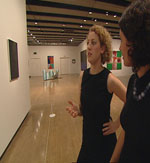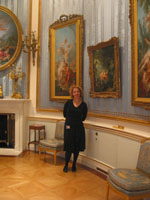Museum Curator
Warwick Experience:
I studied History of Art at Warwick from 1999-2002. During this time, I studied a wide range of different periods in the History of Art, from the Trecento to the twentieth century. Having studied languages at school, I took additional Italian classes in the evenings in order to get more out of the Venice term. Spending part of the final year in Italy allowed me to galvanise my interest in Italian art and architecture, to put my language skills to good use and to enjoy the experience of living abroad.
I eventually wrote my third year dissertation on the mythological paintings of Velázquez and their relationship with Titian. By the time I left University, I (like a lot of people I’d imagine) had very little idea of what I actually wanted to do with my degree. I spent two years working in various short-term museum jobs before returning to full-time study and completed a Master’s degree in European painting 1500-1700 at the Courtauld Institute in 2005.
Work Experience:
My interest in working in a museum stems largely from the gratifying experience of pursuing internships. After graduating in 2002, I applied for an internship at the Peggy Guggenheim Collection in Venice, which was an excellent opportunity to improve my Italian as well as to be immersed in a twentieth-century collection. A three-month internship turned into a much longer stay in Italy. The following year, bolstered by this positive experience of living and working abroad, I spent three months as an intern at the Chinati Foundation in West Texas, and a further three months learning Spanish in Mexico. Having studied Modern American Art at Warwick, this work placement was a wonderful means of consolidating my interest in the period and to improve my communication and interpersonal skills (which are essential in any job, not least in museum work). At both museums, I worked closely on education projects for children visiting the museum and gave talks and tours of the collections, and this is something I regularly do at the Wallace Collection.
Job description:
My job was initially to cover the work of The Wallace Collection’ s Curator of Pictures pre-1800, who was away from the museum for a year. My contract was recently extended and I am now responsible for a photography project which will aid in the visual cataloguing of the museum’s collection. In general, my main duties are to research and care for the museum’s collection of pictures pre-1800, with particular responsibility for Dutch and Flemish paintings, and to work alongside the Exhibitions Curator and Conservation staff in the planning and implementation of the museum’s exhibitions programme. I spend quite a bit of time giving gallery talks and lectures, which I enjoy immensely. The job involves substantial research: I am working on a curatorial project on the Dutch painter Adriaen van der Werff and hope to publish an article on his work in the near future. I also organise seminars in the History of Collecting held at the museum.
Securing the job:
Upon completing my MA, I was awarded a grant to research and catalogue twenty Dutch and Flemish Old Master paintings owned by Sheffield Museums and Galleries Trust. This was a short-term project, based partly in Sheffield and partly at the National Gallery, London, and involved documenting and photographing works, determining conservation priorities, and writing short reports on each picture. This experience of curatorial work allowed me to gain a sound insight into the work of museums and stood me in good stead for working with paintings in the future.
The Good:
I enjoy my job a great deal. Not only do I have the opportunity to work with an outstanding collection of paintings, but I also work in a stimulating and constantly evolving environment. Working in a museum is a wonderful way of building on your academic knowledge and it’s always very satisfying to learn new things. One of the best things is the creative freedom afforded by curatorial work and if you derive pleasure from reading, researching and writing, then you’ll enjoy this element of the job. Museums are also a good place to meet people and interact with a diverse public. More importantly, working in a museum enables you to build an awareness of the needs of the public, and you have to be able to communicate scholarship in an effective and non-specialist way.
The Not-So-Good:
Museum jobs do not pay particularly well compared to other jobs in the public sector. While my job allows me the pleasure of dictating my own agenda, this can often be a double-edged sword: you need to be disciplined and organized. Working on exhibitions can also be very demanding, both physically and mentally, especially as deadlines approach and I find myself cleaning paint from the floor or sticking text labels to the walls…
For further information, see:
London museum of fine and decorative arts, particularly rich in French eighteenth century fine and decorative arts, Sèvres porcelain, Dutch and Flemish paintings, arms and armour.
Former palazzo of Peggy Guggenheim, outstanding collection of twentieth century paintings and sculpture. The museum offers paid internships for students and recent graduates.
Museum established by the American sculptor Donald Judd, who chose the location (in the Chihuahua desert in west Texas) specifically for its remoteness. The museum offers paid internships for students with an interest in twentieth-century American art.
Website which is updated daily and gives information on current vacancies in museums in the UK and abroad.
Words of wisdom:
To work in a museum, it’s necessary to show a genuine enthusiasm and interest for the collection. Doing work experience (which is usually unpaid) is almost always necessary in order to demonstrate willingness. To work in a curatorial department, you will need excellent research skills and a strong academic background. You almost always need a postgraduate degree, an MA at the least, and ideally a PhD. Language skills are also very highly valued. The competition for these jobs is fierce, and so I would advise maintaining a positive outlook and being proactive at every opportunity.
Contact details:
Assistant Curator of Pictures pre-1800
Email: sophie.carr@wallacecollection.org
Our expert:
Sophie Carr


